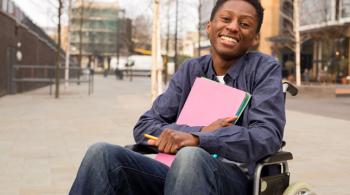By Lisa Carey
February 6, 2018

My pre-service teacher education did not cover trauma. When I first became a teacher, the impact of trauma on student learning was not a common topic of discussion. Because of my background in applied behavior analysis, I was asked to help lead a program for students with emotional and behavioral disabilities. I was lucky to collaborate with some incredible mental health professionals, but in terms of instructional practices, we still didn’t discuss traumatic stress specifically. My students, however, had certainly faced multiple traumatic events in their lives. I knew about these events. My knowledge of their lives helped me approach my students with compassion rather than frustration when they displayed aggressive, disruptive, or defiant behaviors in their classrooms. Yet, as I reflect on those years of attempting to support students who had experienced trauma, I wish I could jump in a time machine and supply my former self with the knowledge I now possess. The following is a list of information I would have liked to have known years ago.
1) The symptoms of traumatic stress
Had I known the symptoms of traumatic stress, I might have been better able to identify student needs, create more robust individualized educational programs, and conduct better training for the teachers working with the students I case managed. I now believe that at times I mistook hyper-vigilance for inattention and ADHD, anger and anxiety for work avoidance, and mistrust of adults for defiance. The National Child Traumatic Stress Network has a lovely guide that can help current educators identify common trauma symptoms at various grade span levels. I wish someone had handed me this resource years ago, but I’m certainly glad to have it now.
2) The impact of stress and anxiety on learning
Several years ago, when I started learning more about the cognitive neuroscience of learning through the Center for Innovation and Leadership in Special Education’s fellowship program, I was struck by how much anxiety can negatively impact both attention and executive function skills(1,2). Attention and executive functions are both needed for students to competently complete tasks and impact academic and social outcomes for students (2–4). When students become anxious, these systems don’t function at their full capacity. Thus, students who originally have strong attentional and executive function skills start to struggle to complete tasks, demonstrate their true level of knowledge, and interact socially. While students can experience anxiety for a multitude of reasons, exposure to traumatic events increases a student’s likelihood of experiences anxiety symptoms. Given my current awareness of the role of anxiety in school struggles, I now help teachers incorporate strategies that can help minimize anxiety in the classroom (e.g. mindfulness) and encourage my fellow educators to be on the lookout for students with anxiety.
3) The importance of fostering relationship building
For the most part I didn’t struggle to build relationships with my students. I was perfectly willing to keep showing up and offering help and kindness, regardless of the response I got. I knew that, in most cases, continuing to be there for them would eventually build relationships. I fell short, however, in helping my fellow teachers build similar relationships. Knowing what I do now about the importance of caring adult relationships and the struggles students who have experienced trauma often face in building these much needed bonds, I’m can’t help but wish I hadn’t been satisfied with concentrating on my own teacher-student relationships.
One amazing trauma informed principal I’ve had the pleasure of working with has a protocol of asking, “Do you have an adult in this building that you trust?” to every student sent to her office. When the answer is no, she works to ensure the staff refocuses on relationship building. As educators, we need to be aware of how important relationships with students are, particularly for those who have experienced trauma. As Dr. Kaufman points out in her interview, this is the population of students who may have the hardest time building the very relationships they need. As educators, it is important that we focus not only on our own teacher-student relationships, but that we help our peers to build rapport with students as well.
4) The difference between pity and compassion
When we find out about some of the horrific experiences our students have endured, it can lead to some pretty strong emotions. We might feel sad, angry toward those who caused the child harm, frustration, pity, and compassion. All of these feelings are normal. But, it is important to point out that pity and compassion are not the same thing and can lead to very different outcomes for educators. According to the Stanford Center for Compassion and Altruism Research and Education, compassion is a “concern for the wellbeing of others” and “it includes kindness, empathy, generosity, and acceptance.” An educator who approaches teaching a child who has experienced trauma with compassion will focus on helping the student by recognizing their needs and supporting them in meeting high standards. Pity, however, can be a trap of low expectations. By pitying students we run the risk of lowering standards and removing demands that foster learning because we feel badly for a student. At times, in trying to ensure that my colleagues were meeting students’ needs, I may have inadvertently elicited a pity response. Some student’s stories were so intense, that I fell into the pity trap as well. Remember, our first duty as educators is to educate students. Pity does not help us to do our best at guiding learning. We need to focus on compassion instead.
While I can’t jump in a time machine and provide my former self with these important pieces of information, it is comforting to know that the conversation surrounding trauma informed teaching is growing momentum. It is my hope that by sharing information and resources the Linking Research to Classroom Blog is able to equip educators with the information needed to participate in this conversation. As a good friend and fellow educator once told me, “teaching is hard work, but it’s good work.”
References:
- Barkley R. The executive functions and self-regulation; an evolutionary neuropychological perspective. Neuropsychol Rev. 2001;11(1):1–29.
- Diamond A. Executive functions. Annu Rev Psychol [Internet]. 2013 [cited 2017 Mar 13];64:135–68. Available from: http://www.ncbi.nlm.nih.gov/pubmed/23020641
- Mann TD, Hund AM, Hesson-mcinnis MS, Roman ZJ. Pathways to School Readiness : Executive Functioning Predicts Academic and Social – Emotional Aspects of School Readiness. Mind, Brain, Educ. 2016;11(1):21–31.
- Jacobson LA, Carey LB. Supporting Executive Functions in the Classroom: Improve Student Learning. In: Council for Exceptional Children National Professional Development Webinar. Council for Exceptional Children; 2016.















